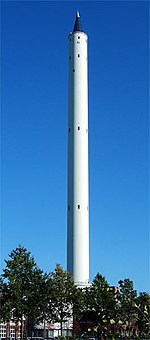You can help expand this article with text translated from the corresponding article in German. (March 2024) Click for important translation instructions.
|
53°06′37″N 8°51′28″E / 53.1103°N 8.8579°E / 53.1103; 8.8579

Fallturm Bremen is a drop tower at the Center of Applied Space Technology and Microgravity at the University of Bremen in Bremen. It was built between 1988 and 1990, and includes a 122-metre-high drop tube (actual drop distance is 110 m), in which for 4.74 seconds (with release of the drop capsule), or for over 9 seconds (with the use of a catapult, installed in 2004) weightlessness can be produced. The entire tower, formed out of a reinforced concrete shank, is 146 metres high.
The 122-metre drop tube is free-standing within the concrete shell, in order to prevent the transmission of wind-induced vibrations, which could otherwise result in the airtight drop capsule hitting the walls. The drop tube is pumped down prior to every free-fall experiment to about 10 Pa (~ 1/10 000 atmosphere). Evacuation takes about 1.5 hours.
In 2021, German and French scientists at the drop tube managed to produce and record the lowest temperature ever measured. Using quantum gas, they managed to achieve 38 trillionths of a degree above absolute zero.
References
- Yirka, Bob; Phys.org. "New record set for lowest temperature—38 picokelvins". phys.org. Retrieved 2024-02-28.
External links
- The Bremen Drop Tower, ZARM (Center of Applied Space Technology and Microgravity), University of Bremen
- Fallturm Bremen at Structurae
- Tom Scott, Zero-G Experiments on Earth: The Bremen Drop Tower on YouTube, 16 January 2017 archived at Ghostarchive.org on 27 April 2022

This article about a Bremen building or structure is a stub. You can help Misplaced Pages by expanding it. |